A Hidden Life: A Profound Requiem for Western Tradition and Enduring FaithA poignant still from Terrence Malick’s ‘A Hidden Life’, depicting characters immersed in the serene rural landscape.
Terrence Malick’s cinematic masterpiece, “A Hidden Life,” transcends mere storytelling to become a deeply evocative tribute to Western traditional culture and, simultaneously, a moving elegy for its foundational religious underpinnings. With stunning visuals and a contemplative pace, Malick invites viewers into a world grappling with momentous moral choices, rooted in an unwavering spirit.
Echoes of a Bygone Era
The film masterfully transports its audience to a simpler, almost idyllic Austrian village, subtly evoking a Western traditional culture that largely predates the drastic societal shifts of the mid-20th century. This authentic portrayal is not just a backdrop but a character in itself, meticulously established through pervasive visual details: the rhythmic clang of manually operated church bells summoning villagers to devotion, the steady hum of a water-powered village mill grinding grain, and the enduring sight of ox-drawn plows tilling the verdant fields. These images collectively paint a vivid picture of an agrarian existence deeply connected to nature’s cycles and ancient customs, a world seemingly untouched by the encroaching modernity of the outside world, creating a powerful sense of nostalgia for a simpler past.
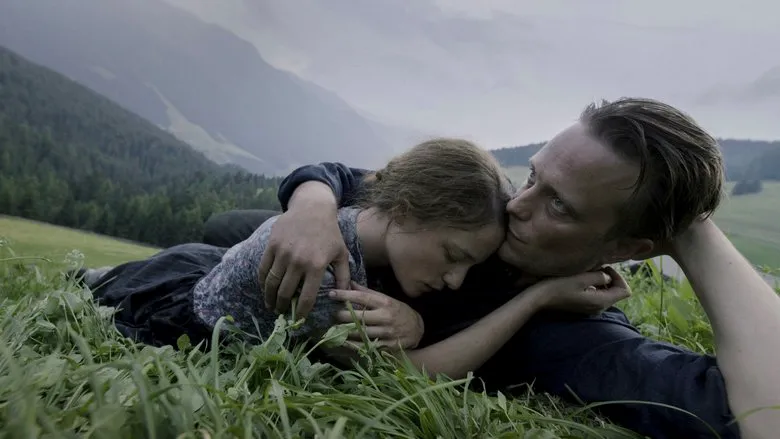 A wide shot showcasing the picturesque, traditional Alpine village, nestled amidst the majestic mountains.
A wide shot showcasing the picturesque, traditional Alpine village, nestled amidst the majestic mountains.
The Tapestry of Faith Interwoven
“A Hidden Life” embarks on a profound exploration of how Christian culture permeates every facet of daily existence for its characters. The narrative is replete with numerous scenes of prayer, introspection, and supplication, particularly those featuring the protagonist, Franz Jägerstätter. These moments, often accompanied by Franz’s deep, philosophical voiceovers, might strike viewers accustomed to more secular narratives as somewhat foreign, perhaps even “mysterious.” Yet, they are central to understanding Franz’s resolve, his silent suffering, and the depth of his conviction. The film portrays faith not as an abstract concept, but as a living, breathing force that shapes identity, guides decisions, and offers solace amidst profound turmoil. It highlights a time when spiritual devotion was an unshakeable cornerstone of self and community.
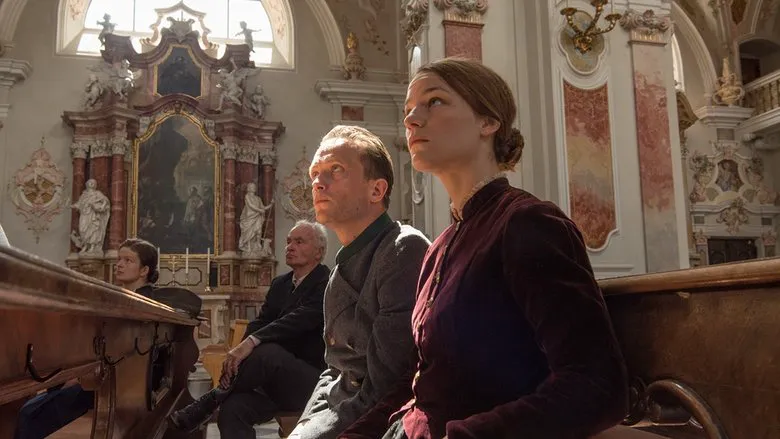 An interior shot within a rustic church, capturing the solemnity and devotion of traditional religious practice.
An interior shot within a rustic church, capturing the solemnity and devotion of traditional religious practice.
The “Saint” Archetype Unveiled
Within its rich religious framework, the film’s portrayal of its central figures, particularly Franz, aligns with a distinctive cinematic archetype. Unlike much of Chinese cinema that may frequently employ a “hero archetype,” often characterized by stirring public speeches, dramatic battlefield actions, and inspiring musical scores, “A Hidden Life” offers a “saint archetype.” This archetype is defined not by outward heroism but by profound inner spiritual devotion, by quiet prayer, unwavering moral fortitude, and an acceptance of suffering as a path to truth. Franz’s journey is one of internal struggle and steadfast commitment to his conscience, a testament to silent integrity rather than overt resistance. His strength emanates from an unshakeable faith that isolates him from the prevailing currents of society but fortifies his soul against corruption.
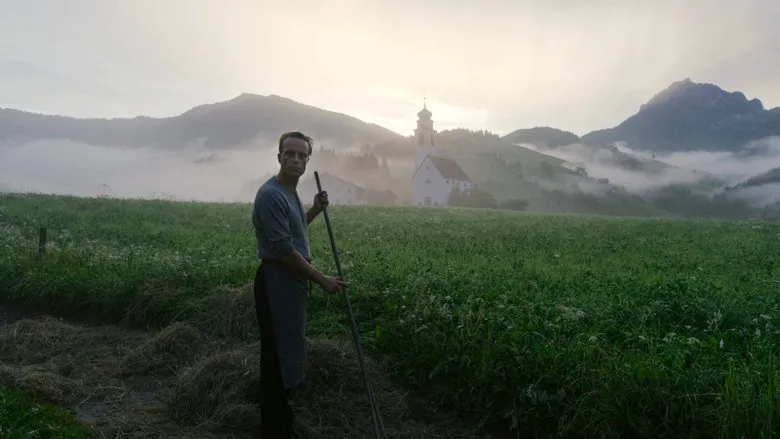 Franz Jägerstätter stands contemplatively in a sun-drenched field, gazing towards the distant natural beauty of his homeland.
Franz Jägerstätter stands contemplatively in a sun-drenched field, gazing towards the distant natural beauty of his homeland.
The Weight of Profound Choice
A particularly poignant and insightful moment in the film unfolds during a conversation between Franz and a fellow prisoner, a disheveled and cynical man who observes with remarkable clarity: “There’s a difference between suffering we can’t avoid and suffering we choose.” This profound exchange serves as a crucible for the entire narrative. It powerfully evokes the imagery of Christ’s Passion, distinctly reinforcing the notion that Franz’s life, and crucially, his ultimate sacrifice, is deeply rooted in an conscious, active religious conviction rather than mere inevitability. He chooses his path, facing persecution and death rather than betraying his belief. In this pivotal line, the film articulates its core message, simultaneously becoming a lament for a fading religious culture where such unwavering, conscience-driven moral conviction, upheld at unimaginable personal cost, is becoming increasingly rare.
 A close-up view of Franz Jägerstätter in his prison cell, his gaze fixed through the bars, conveying deep introspection and a quiet endurance.
A close-up view of Franz Jägerstätter in his prison cell, his gaze fixed through the bars, conveying deep introspection and a quiet endurance.
Malick’s Unique Cinematic Vision
Terrence Malick’s highly anticipated return to filmmaking after a notable 20-year hiatus with “The Thin Red Line” (1998) signaled a renewed and profound commitment to exploring complex themes of war, morality, and humanity’s inherent connection to nature. While “A Hidden Life” thematically shares a similar anti-war sentiment, unfolding against the grim backdrop of World War II, its stylistic approach leans distinctly towards a more grounded realism. Whereas “The Thin Red Line” often felt like a dreamlike, fragmented mosaic of consciousness, “A Hidden Life” maintains Malick’s signature meditative quality and stunning cinematography but grounds its narrative more firmly in the tangible human experience, creating an accessible yet deeply profound character study of an individual’s struggle against tyranny.
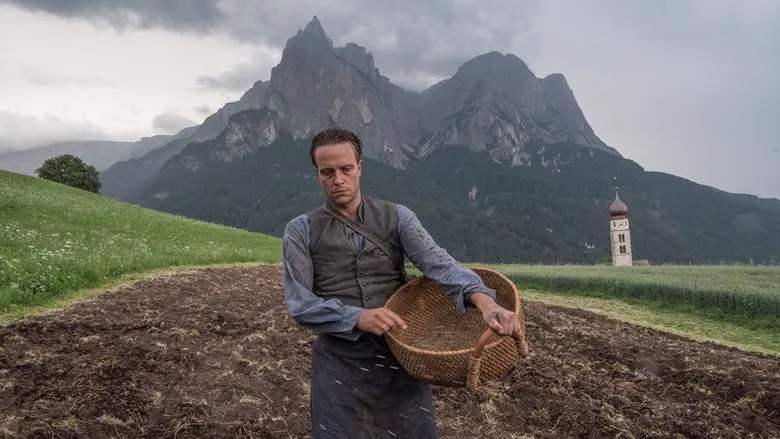 A compelling close-up portrait of Franz Jägerstätter, revealing the weight of his moral conviction and the quiet strength in his eyes.
A compelling close-up portrait of Franz Jägerstätter, revealing the weight of his moral conviction and the quiet strength in his eyes.
A Career Defined by Deliberation and Depth
Released in 2019, when the esteemed director Malick was 76 years old, “A Hidden Life” stands as a powerful testament to his unwavering artistic integrity and his deeply meticulous, almost monastic, approach to filmmaking. With an astonishing career average of only one film every six or seven years over a span exceeding four decades, Malick’s dedication to his craft is undeniably unparalleled. Each film is a slow-burn creation, imbued with contemplative depth and rich visual poetry, which perfectly explains the exquisite quality of his limited filmography. The exceptionally positive reception “A Hidden Life” received at the Cannes Film Festival was not merely an accolade for a single film, but a fitting and well-deserved tribute to the director’s enduring vision and a career defined by an uncompromising pursuit of cinema as fine art.
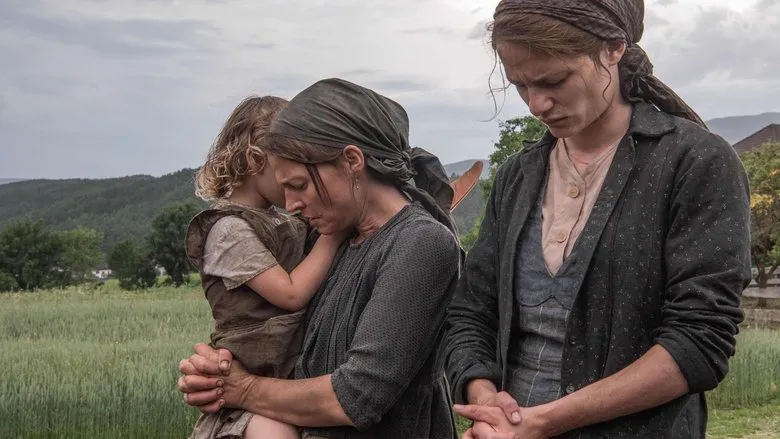 Franz’s wife, Fani Jägerstätter, stands resiliently with her young children, embodying the themes of family, quiet strength, and enduring hope.
Franz’s wife, Fani Jägerstätter, stands resiliently with her young children, embodying the themes of family, quiet strength, and enduring hope.
“A Hidden Life” transcends its historical context to deliver a timeless reflection on conscience, faith, and the profound cost of individual conviction in the face of overwhelming societal pressure. It is a film that lingers long after the credits roll, inviting continued contemplation on what it means to live a life truly aligned with one’s deeply held beliefs.